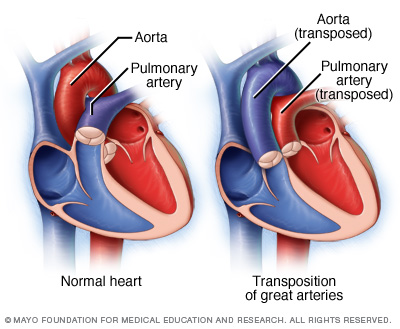Page Contents
OVERVIEW
Transposition of the great vessels (TGV) refers to the switched positions of the aorta and the pulmonary artery. In this condition the aorta arises form the right ventricle while the pulmonary artery arises from the left ventricle.

WHAT CAUSES IT?
Abnormal rotation of the great vessels during cardiac development is responsible for this condition.
WHY IS THIS A PROBLEM?
The switching of these great vessels causes blood to loop in two particular paths:
- Deoxygenated blood from the body is pumped directly back to the body through the aorta (and never reaches the lungs)
- Oxygenated blood from the lungs is pumped directly back to the lungs through the pulmonary artery (and is never delivered to other areas of the body).
The end result of this is that oxygenated blood never reaches the tissues of the body, causing cyanosis.
WHAT MAKES US SUSPECT IT?
Initial Presentation:
Congenital disorders, including disease in adults
Physical Exam:
Cardiovascular Exam:
- Single S2 heart sound heard
- VSD murmur may or may not be present
CLINICAL WORKUP
Chest X-Ray can reveal a “egg on a string” heart (marked by a narrow mediastinum).
OTHER INFO
This is the most common congenital cyanotic heart disease in the neonatal period.
ARCHIVE OF STANDARDIZED EXAM QUESTIONS
This archive compiles standardized exam questions that relate to this topic.
Page Updated: 11.25.2016